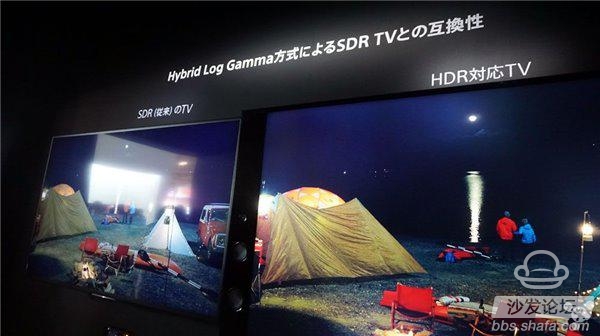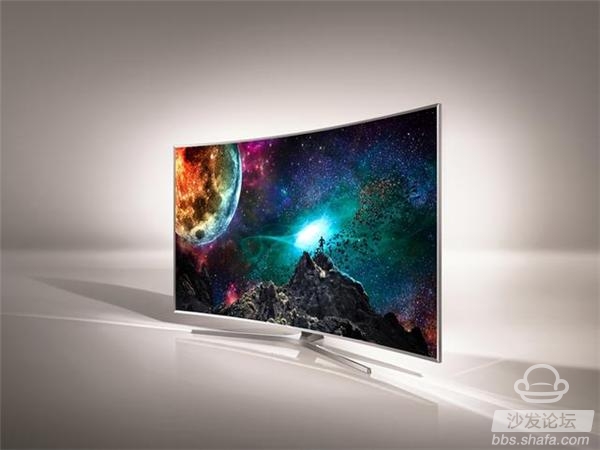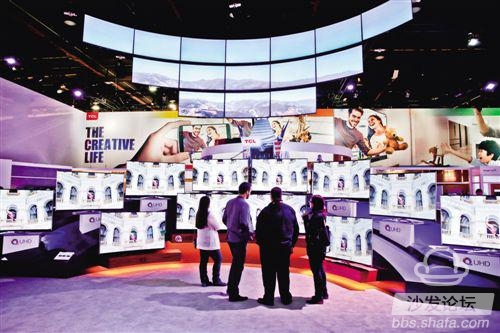Network dramas such as "Prince Edward" have encountered rigorous control by the regulatory authorities. This shows that in the Chinese market, it is still more difficult for companies to rely on content to create a unique and exclusive television business ecosystem. Even the 4K ultra high-definition televisions, which are currently in the domestic market, are still facing the bottleneck of lack of film sources.
Hardware upgrade is rich in content
As we all know, when Internet TV manufacturers advertise their own content features, they are accustomed to attracting users with 100,000 videos, variety shows, and sports. However, in fact, in terms of 4K ultra high-definition film and television drama, sports, etc., it is still stretched.
In the past two years, with the popularity of 4K ultra-high-definition televisions, companies including Sony, Samsung, and TCL have accelerated their follow-up of content. For example, Sony (SONY) owns its own Sony Pictures (including Columbia Pictures). TCL named the Hollywood China Grand Theatre in the United States. The company was featured in several Hollywood blockbuster promotions last year, while Samsung and some US TV shows. Content manufacturers have a close relationship.

Therefore, compared with the content of the Internet TV companies in the previous two years to replace the hardware price war, the current hardware technology to promote content creation has become the mainstream in the industry. It is the rise of 4K TV that makes the production of film and television dramas, sports, and variety shows in the upper reaches to 4K ultra high-definition shooting and live broadcasting.
In the long run, the content of the next 100,000+ 4K movie and TV dramas will be sooner or later. With the accumulation of time, everyone will have them. However, only 4K content is not enough to meet the needs of high-end color TV companies. The transition to high-end is not just a matter of using a new technology, because the criticalness of high-end customers is extremely demanding. In addition to developing new technologies, color TV manufacturers still need to 4K video content and hardware adaptation, the image quality will be more perfect in front of the user. Therefore, for China's color TV industry, it is still an era of hardware outbreaks for future content.
At the beginning of 2015, we saw the dispute between curved LCD TVs and ultra-thin LCD TVs. In the second half of 2015, we saw the debate between OLED and laser TV. In early 2016, we saw that quantum TV became one of the mainstream TV display technologies.

The common goal of color TV diversity era
In the opinion of many people, the price war between Internet TV manufacturers and the hardware value war of veteran manufacturers, and the mainstream display technology war among established TV manufacturers, the TV industry always has a lot of line arguments. Everyone is emphasizing themselves and others. the difference. However, at the 2016 CES, many of the world’s mainstream color TV companies, including China, Korea, and Japan, have done an unimaginable synergy – HDR.
In the continuous color TV industry, the market is in the doldrums and competition is fierce. All major manufacturers are striving for differentiated technologies, differentiated products, and differentiated user groups. New technologies that everyone wants to recognize and jointly promote are natural. A very rare thing.

Publicly available data shows that HDR (High-Dynamic Range), also known as "high dynamic range image," can accommodate both light and dark details. TVs equipped with HDR technology can significantly improve the screen display contrast and color range. The bright part of the screen will be clearer, the dark part will be more depth, the appearance will be clear, and the color accuracy will also make the color look more Pure and bright.
Image quality determines product competitiveness
To say that HDR's reputation rises, one is the Sony of technology and the other is the biggest Samsung. Let's look at Sony first. Although the sales performance of Sony TV is now much weaker than that of Chinese companies, the image of Sony's technology and technology favored by cable powder is still deeply rooted.
Sony HDR is supported by the 4K sharp image processing engine PRO technology, Terricolor display technology and Advanced Optical PRO technology. According to HomeNet, Sony TV business reforms in the past two years have focused on 4K high-end color TV market for profit, so Sony HDR TVs focus on large-size product lines, and one is focused on high-end, high-priced, and high-profile products.
Therefore, in the consumer TV market of the affluent class, Sony's quality image does not actually have a big gap. This is why Sony regards promotion of HDR as a key point, because it is the key to Sony's competition in the high-end market with rivals such as Samsung, LG, and TCL.
Next, let's take a look at Samsung. According to the description of Samsung CES2016, the new SUHD TV supporting HDR technology has a maximum brightness of 1000 nit (NIT), which creates a stronger contrast between bright and dark images and a more vibrant and bright color texture.
As we mentioned above, Samsung TV has a close relationship with content carriers, 4K video streaming, Samsung and YouTube, Netflix and other content providers deepen cooperation. Samsung is also preparing UHD Blu-ray players that will support the playback of HDR videos. , and with the quantum technology on television.
According to industry sources, the HDR technology significance lies in providing an industry standard with image quality as its core. The quality of the image determines the competitiveness of the product. The UHD Alliance announced the use of HDR as the core high-end UHD certification standard - "Ultra HD Premium "This will undoubtedly bring a demonstration effect to the entire industry and drive the rapid development of the HDR content ecosystem.
According to home network observation, Samsung TV has a high probability of HDR for this year's keywords. U.S. online video service providers YOUTUBE, Netflix, and Amazon have promised to support HDR video programs, and the US market is the top priority of Samsung TV's global business.
Full ecological HDR solution
Although everyone has HDR technology, a complete solution for HDR end-to-end is different. The main difficulties are the chip end and the display end. At present, the upstream chip supplier, such as the chip supplier Realtek Semiconductor, has already launched an integrated chip capable of HDR10 decoding.
In China's color TV enterprises, TCL's ecological HDR is worthy of attention in the industry for HDR system solutions. This is a complete HDR solution that can achieve content, hardware, and software to fully meet HDR standards, enabling users to watch HDR standards in real time. effect.
For example, in terms of content, TCL deeply cooperates with Hollywood to timely launch HDR video resources through a global broadcast platform. On the other hand, TCL can also convert ordinary content into HDR standard content to meet users' real-time viewing needs. In terms of hardware technology, the full 4K HDR technology needs to meet requirements in terms of interface, chip, backlight, and screen body. In terms of software, the company has three HDR real-time conversion technologies with core technology patents that can realize image enhancement algorithms that convert SDR (ordinary image quality) to HDR image quality in real time.
In view of the giants such as Samsung and Sony, HDR also requires higher-end screens, image quality processing, and display technologies. According to Wang Yulin, vice president of TCL Multimedia, HDR is a revolution because HDR's entire shooting, transmission, and display technologies are all new standards. This brings users a completely different sense of sight and hearing. HDR should be the most important in 2016. One of the important features of a technology is that it performs very well in terms of contrast.
According to the home network, during the 2016 Spring Festival color TV sales period, TCL is likely to be ahead of domestic and foreign peers to upgrade its full-line HDR mid-to-high-end products. At that time, consumers can go to the store to personally experience upgraded HDR products.
According to market research firm ABI Research, approximately 70% of 4K ultra high-definition televisions will support new technologies such as high dynamic range (HDR), wider color gamut, high frame rates, and immersive audio in 2020. IHS predicts that HDR TV shipments will increase significantly in the future, with an estimated 2.9 million units in 2016 and an expected 32.6 million units by 2019.
According to HomeNet, many HDR-enabled TVs have entered the market first, HDR-compatible TV shows and movies are also available for online viewing, and HD Blu-ray discs with HDR are coming soon. The Consumer Electronics Association (CEA) ) It was also announced recently that the industry definition of high dynamic range (HDR) compatible video displays will be set out.
Hardware upgrade is rich in content
As we all know, when Internet TV manufacturers advertise their own content features, they are accustomed to attracting users with 100,000 videos, variety shows, and sports. However, in fact, in terms of 4K ultra high-definition film and television drama, sports, etc., it is still stretched.
In the past two years, with the popularity of 4K ultra-high-definition televisions, companies including Sony, Samsung, and TCL have accelerated their follow-up of content. For example, Sony (SONY) owns its own Sony Pictures (including Columbia Pictures). TCL named the Hollywood China Grand Theatre in the United States. The company was featured in several Hollywood blockbuster promotions last year, while Samsung and some US TV shows. Content manufacturers have a close relationship.

Therefore, compared with the content of the Internet TV companies in the previous two years to replace the hardware price war, the current hardware technology to promote content creation has become the mainstream in the industry. It is the rise of 4K TV that makes the production of film and television dramas, sports, and variety shows in the upper reaches to 4K ultra high-definition shooting and live broadcasting.
In the long run, the content of the next 100,000+ 4K movie and TV dramas will be sooner or later. With the accumulation of time, everyone will have them. However, only 4K content is not enough to meet the needs of high-end color TV companies. The transition to high-end is not just a matter of using a new technology, because the criticalness of high-end customers is extremely demanding. In addition to developing new technologies, color TV manufacturers still need to 4K video content and hardware adaptation, the image quality will be more perfect in front of the user. Therefore, for China's color TV industry, it is still an era of hardware outbreaks for future content.
At the beginning of 2015, we saw the dispute between curved LCD TVs and ultra-thin LCD TVs. In the second half of 2015, we saw the debate between OLED and laser TV. In early 2016, we saw that quantum TV became one of the mainstream TV display technologies.

The common goal of color TV diversity era
In the opinion of many people, the price war between Internet TV manufacturers and the hardware value war of veteran manufacturers, and the mainstream display technology war among established TV manufacturers, the TV industry always has a lot of line arguments. Everyone is emphasizing themselves and others. the difference. However, at the 2016 CES, many of the world’s mainstream color TV companies, including China, Korea, and Japan, have done an unimaginable synergy – HDR.
In the continuous color TV industry, the market is in the doldrums and competition is fierce. All major manufacturers are striving for differentiated technologies, differentiated products, and differentiated user groups. New technologies that everyone wants to recognize and jointly promote are natural. A very rare thing.

Publicly available data shows that HDR (High-Dynamic Range), also known as "high dynamic range image," can accommodate both light and dark details. TVs equipped with HDR technology can significantly improve the screen display contrast and color range. The bright part of the screen will be clearer, the dark part will be more depth, the appearance will be clear, and the color accuracy will also make the color look more Pure and bright.
Image quality determines product competitiveness
To say that HDR's reputation rises, one is the Sony of technology and the other is the biggest Samsung. Let's look at Sony first. Although the sales performance of Sony TV is now much weaker than that of Chinese companies, the image of Sony's technology and technology favored by cable powder is still deeply rooted.
Sony HDR is supported by the 4K sharp image processing engine PRO technology, Terricolor display technology and Advanced Optical PRO technology. According to HomeNet, Sony TV business reforms in the past two years have focused on 4K high-end color TV market for profit, so Sony HDR TVs focus on large-size product lines, and one is focused on high-end, high-priced, and high-profile products.
Therefore, in the consumer TV market of the affluent class, Sony's quality image does not actually have a big gap. This is why Sony regards promotion of HDR as a key point, because it is the key to Sony's competition in the high-end market with rivals such as Samsung, LG, and TCL.
Next, let's take a look at Samsung. According to the description of Samsung CES2016, the new SUHD TV supporting HDR technology has a maximum brightness of 1000 nit (NIT), which creates a stronger contrast between bright and dark images and a more vibrant and bright color texture.
As we mentioned above, Samsung TV has a close relationship with content carriers, 4K video streaming, Samsung and YouTube, Netflix and other content providers deepen cooperation. Samsung is also preparing UHD Blu-ray players that will support the playback of HDR videos. , and with the quantum technology on television.
According to industry sources, the HDR technology significance lies in providing an industry standard with image quality as its core. The quality of the image determines the competitiveness of the product. The UHD Alliance announced the use of HDR as the core high-end UHD certification standard - "Ultra HD Premium "This will undoubtedly bring a demonstration effect to the entire industry and drive the rapid development of the HDR content ecosystem.
According to home network observation, Samsung TV has a high probability of HDR for this year's keywords. U.S. online video service providers YOUTUBE, Netflix, and Amazon have promised to support HDR video programs, and the US market is the top priority of Samsung TV's global business.
Full ecological HDR solution
Although everyone has HDR technology, a complete solution for HDR end-to-end is different. The main difficulties are the chip end and the display end. At present, the upstream chip supplier, such as the chip supplier Realtek Semiconductor, has already launched an integrated chip capable of HDR10 decoding.
In China's color TV enterprises, TCL's ecological HDR is worthy of attention in the industry for HDR system solutions. This is a complete HDR solution that can achieve content, hardware, and software to fully meet HDR standards, enabling users to watch HDR standards in real time. effect.
For example, in terms of content, TCL deeply cooperates with Hollywood to timely launch HDR video resources through a global broadcast platform. On the other hand, TCL can also convert ordinary content into HDR standard content to meet users' real-time viewing needs. In terms of hardware technology, the full 4K HDR technology needs to meet requirements in terms of interface, chip, backlight, and screen body. In terms of software, the company has three HDR real-time conversion technologies with core technology patents that can realize image enhancement algorithms that convert SDR (ordinary image quality) to HDR image quality in real time.
In view of the giants such as Samsung and Sony, HDR also requires higher-end screens, image quality processing, and display technologies. According to Wang Yulin, vice president of TCL Multimedia, HDR is a revolution because HDR's entire shooting, transmission, and display technologies are all new standards. This brings users a completely different sense of sight and hearing. HDR should be the most important in 2016. One of the important features of a technology is that it performs very well in terms of contrast.
According to the home network, during the 2016 Spring Festival color TV sales period, TCL is likely to be ahead of domestic and foreign peers to upgrade its full-line HDR mid-to-high-end products. At that time, consumers can go to the store to personally experience upgraded HDR products.
According to market research firm ABI Research, approximately 70% of 4K ultra high-definition televisions will support new technologies such as high dynamic range (HDR), wider color gamut, high frame rates, and immersive audio in 2020. IHS predicts that HDR TV shipments will increase significantly in the future, with an estimated 2.9 million units in 2016 and an expected 32.6 million units by 2019.
According to HomeNet, many HDR-enabled TVs have entered the market first, HDR-compatible TV shows and movies are also available for online viewing, and HD Blu-ray discs with HDR are coming soon. The Consumer Electronics Association (CEA) ) It was also announced recently that the industry definition of high dynamic range (HDR) compatible video displays will be set out.
For Xiaomi Glass,Xiaomi Mi A2 Oca Glass,Touch Screen Front Glass For Xiaomi,Xiaomi 11 Front Glass
Dongguan Jili Electronic Technology Co., Ltd. , https://www.ocasheet.com
